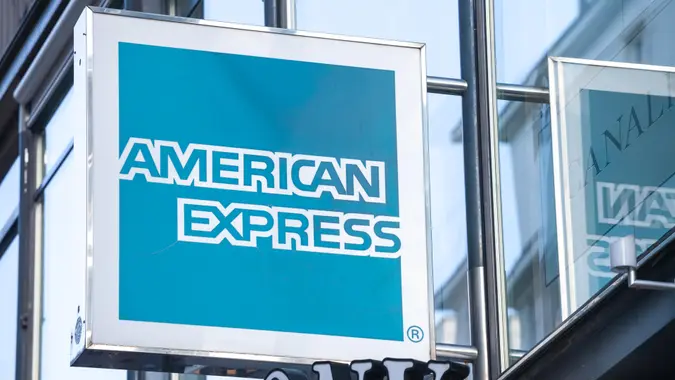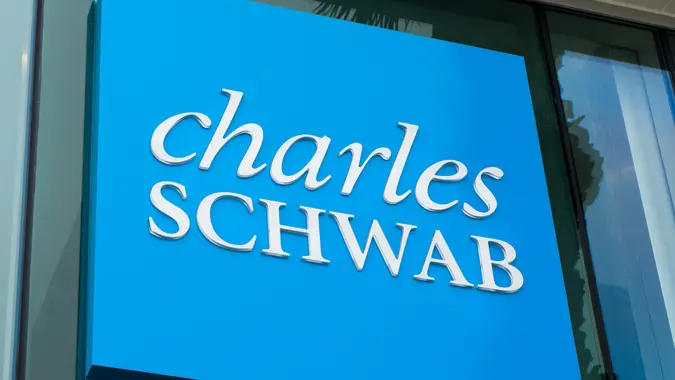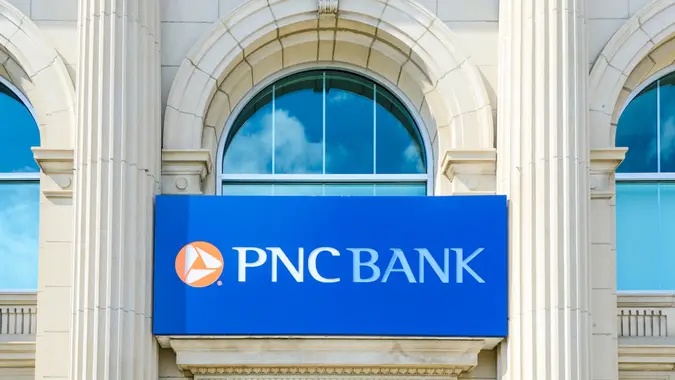Bank of America vs. Capital One: Which Bank Is Better?

Commitment to Our Readers
GOBankingRates' editorial team is committed to bringing you unbiased reviews and information. We use data-driven methodologies to evaluate financial products and services - our reviews and ratings are not influenced by advertisers. You can read more about our editorial guidelines and our products and services review methodology.

20 Years
Helping You Live Richer

Reviewed
by Experts

Trusted by
Millions of Readers
The right bank can make managing your finances easier. The specific features offered by a bank can help you streamline your financial management to avoid unnecessary hassles. But since everyone has different money management preferences, the best bank for you varies based on your unique situation.
Bank of America, Member FDIC, and Capital One are popular banking options in the U.S. We will explore how these two financial institutions stack up against each other to determine which bank better suits your needs.
Quick Overview of Capital One Vs Bank of America
Capital One benefits:
- Rewards credit cards
- Attractive APYs on deposit accounts
- No monthly fee for a checking account
Bank of America benefits:
- Expansive physical footprint
- Home loans available
- Rewards credit cards
| Capital One | Bank of America | |
|---|---|---|
| Branch locations | 263 | 3,700+ |
| ATM locations | 70,000+ | 15,000+ |
| Types of accounts offered | Checking account, savings account, CDs, credit cards, auto loans, business loans | Checking accounts, savings accounts, CDs, credit cards, home loans, auto loans |
Account Types Comparison: Capital One vs. Bank of America
Not surprisingly for the second largest bank in the country, Bank of America offers a big range of products. Some of the products offered include checking accounts, savings accounts, certificates of deposit, credit cards, home loans, auto loans and investment advising. The robust selection presents an opportunity to manage all of your financial needs in a single place.
As a smaller bank, Capital One offers a bit less variety, but many can still find exactly what they are looking for. Some of the products offered include credit cards, checking accounts, savings accounts, certificates of deposit, auto loans and small business banking.
While the details vary from account to account, Capital One accounts tend to come with lower fees and higher APYs. For example, the Bank of America Advantage Plus Banking account comes with a waivable $12 monthly fee. But Capital One’s 360 Checking account doesn’t come with any monthly fees. That’s one example of why Capital One won the honor of Best National Bank in GoBankingRates’ Best Banks of 2025 ranking.
Capital One and Bank of America each offer a wide selection of account offerings. The table below highlights the key accounts offer by each bank.
| Capital One | Bank of America | |
|---|---|---|
| Checking | 360 Checking account: No minimum balance, no overdraft fees, no monthly fees | Several checking accounts, including: SafeBalance Banking for Family Banking, Advantage Safe Balance Banking, Advantage Plus Banking and Advantage Relationship Banking |
| Savings | 360 Savings account: No minimum balance, no monthly fees | Advantage Savings: $100 minimum opening deposit, waiveable monthly fee |
| CDs | 360 CDs: No minimum balance, Terms of six to 60 months | Terms of 28 days to 120 months, minimum balance requirement of $1,000 |
| Credit cards | Several credit cards, including: Platinum Secured, VentureOne Rewards, Venture X Rewards | Several credit cards, including: Bank of America Customized Cash Rewards, Bank of America Unlimited Cash Rewards, BankAmericard |
| Loans | Auto loans | Home loans, auto loans |
Interest Rates Comparison: Capital One vs. Bank of America
Savers who want to put their hard-earned dollars to work can find more value through Capital One’s attractive APYs*.
The table below highlights APYs across multiple account types at each bank.
| Capital One | Bank of America | Notes | |
|---|---|---|---|
| Checking Accounts | APY | to APY | BoA only offers one interest bearing account |
| Savings Accounts | APY | APY | N/A |
| CDs | to APY | to APY | N/A |
Fees Comparison: Capital One vs. Bank of America
Generally, you’ll face more fees through Bank of America accounts than Capital One accounts. But the fees you encounter vary based on the account type you choose and how you use the account.
The table below highlights some of the fees you might encounter with each bank.
| Capital One | Bank of America | |
|---|---|---|
| Monthly fees | None | $0 to $25 per month; varies based on account you have and how you use it |
| Overdraft fees | None | $35 |
| ATM fees | 70,000+ fee-free ATMs | 15,000+ fee-free ATMs |
| Minimum balance requirement | None | Yes, varies based on account type. For example, $1,000 minimum deposit required for a CD. |
Pros and Cons: Capital One vs. Bank of America
Every financial institution has advantages and disadvantages. Below is a look at each for these banks:
- Pros of Capital One: Attractive rates across multiple account types and no minimum balance requirements.
- Pros of Bank of America: Extensive footprint of physical branch locations, mortgages available.
- Cons of Capital One: Limited physical branches and no mortgages available.
- Cons of Bank of America: Higher account fees and less lucrative credit card rewards options.
Capital One vs. Bank of America: Which Bank is Right for You?
Bank of America shines with its ability to cater to your banking needs in person. The large network of physical branches means there is a good chance you can manage your banking needs with the team at your local branch. Additionally, the extensive product offering means it’s conceivable to manage all of your finances with Bank of America. Before you opt to go all in with Bank of America, or any bank, make sure to read all of the product details. You don’t want to get stuck paying for unnecessary fees.
For savers who want to make top APYs a priority, Capital One could be the right fit. You’ll find competitive rates through Capital One that you generally won’t find at bigger banks. For example, the APY attached to Capital One’s 360 Performance Savings account is significantly better than the APY you could possibly snag through Bank of America.
If you are comfortable conducting your banking online, then there’s nothing to detract from moving forward with Capital One.
Takeaway
Capital One and Bank of America both offer an array of financial products. But the right bank varies based on your needs. Before you move forward, consider exploring all of the best banking options to confirm you’ve found the right fit.
FAQ
- What are the fees for Capital One and Bank of America accounts?
- Capital One 360 Savings and Checking accounts don't come with monthly fees.
- Which bank offers better interest rates?
- Overall, Capital One tends to offer higher interest rates than Bank of America.
- How do Capital One's credit cards compare to Bank of America's?
- Overall, Capital One credit cards tend to offer higher rewards-earning potential than Bank of America credit cards. But the right credit card for you varies based on your unique situation and financial goals.
- Does Capital One have physical branches?
- Yes, Capital One has hundreds of physical branches.
Rates are subject to change; unless otherwise noted, rates are updated periodically. All other information on accounts is accurate as of March 11, 2025.
Savings vary depending on account usage and payment behavior. *Capital One interest rates accurate as of 12/4/2025. See website for all current rates.
Editorial Note: This content is not provided by any entity covered in this article. Any opinions, analyses, reviews, ratings or recommendations expressed in this article are those of the author alone and have not been reviewed, approved or otherwise endorsed by any entity named in this article.
Editorial Note: This content is not provided by any entity covered in this article. Any opinions, analyses, reviews, ratings or recommendations expressed in this article are those of the author alone and have not been reviewed, approved or otherwise endorsed by any entity named in this article.
 Written by
Written by  Edited by
Edited by 

























